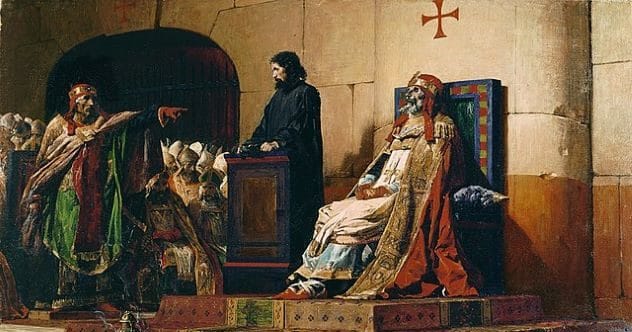Many graves bear the inscription “Rest in Peace.” For most, this holds true as our bodies decompose undisturbed. However, for famous individuals, history reveals a pattern of exhumation, desecration, or general mishandling. It seems even death can’t diminish their allure.
Here are ten instances of strange events involving the corpses of famous figures.
10 Jeremy Bentham
Jeremy Bentham, a key 19th-century English philosopher and founder of Utilitarianism, believed in deriving utility from dead bodies, particularly his own.
Bentham argued against statues, suggesting preserving and displaying corpses instead, terming them “auto-icons.” Upon his death in 1832, he bequeathed his body to a friend for this process. He’d even carried glass eyes for his future display for years.
Unfortunately, the preservation went awry, leaving Bentham’s head looking like a deflated soccer ball. A wax head replaced the real one, which students occasionally stole and ransomed back. Bentham’s body is still displayed at University College London. Rumors of his presence at university council meetings are, sadly, false. [1]
9 The Cadaver Synod
Most popes face the possibility of not being declared a saint after death. However, being the head of the Catholic Church has sometimes been truly perilous. Rivals often denounced actions, and upsetting a king could lead to invasion. Even death didn’t guarantee the end of trials.
Pope Formosus of the 9th century made the error of siding with the wrong Italian power. Seven months after his death, his corpse was exhumed and put on trial by his successor, Stephen VI. In the Cadaver Synod, the dead pope was dressed in his papal attire, seated on a throne, and accused of numerous offenses. An earthquake during the trial was seen by some as divine disapproval, but the synod continued.
Formosus was judged guilty and accused of illegally seizing the papacy. He was stripped of his robes, had his blessing fingers cut off, and was thrown into the Tiber. Stephen VI’s triumph was short-lived. Formosus’s allies regained control of Rome, and Stephen was imprisoned and strangled. [2]
8 Oliver Cromwell
The saying, “if you come for the king, you better not miss,” needs a warning. Even if you successfully replace the king, danger persists. Oliver Cromwell played a crucial role in the English Civil War, leading to the victory of parliamentary forces and the execution of King Charles I.
Cromwell became Lord Protector, a king in all but title. After his death, with the English people tired of Puritan rule, Charles II, the dead king’s son, was invited to reclaim the throne. Charles II was forgiving, except towards those who killed his father.
Charles II ordered the execution of all regicides, even those already dead. Cromwell’s corpse was exhumed and executed. Samuel Sainthill, witnessing the event, noted Cromwell’s well-preserved state. His head was severed after eight blows and displayed on a spike outside Westminster Hall for 20 years before being stolen and passed among collectors. In 1960, it was buried in an unmarked grave at Cambridge College, where Cromwell studied. [3]
7 Inês de Castro
Inês de Castro, of Spanish noble descent, served Constance of Castile when she married Peter, heir to the Portuguese throne, in 1340. Peter fell in love with Inês, not his wife. After Constance’s death, he refused to remarry unless it was to Inês. The King of Portugal, tiring of his son’s infatuation, had Inês beheaded.
When Peter became king, he declared he and Inês had secretly married, making her the rightful queen. He built royal tombs for them to be buried together and had Inês’s corpse exhumed for reburial. Another story tells of Peter’s obsession.
Later tales claim Peter had Inês’s corpse dressed as a queen, placed on a throne, and crowned. Every noble was then forced to kiss her hand and pledge loyalty to their new queen. [4]
6 Eva Peron
Having a musical written about her wasn’t the worst indignity Eva Peron, Argentina’s famed first lady, faced after her death. With her husband, President Juan Peron, she governed Argentina and was beloved by the working class.
By 1952, Eva Peron was terminally ill with cervical cancer and died at 33. Three million attended her funeral, but her body wasn’t buried. A vast statue, larger than the Statue of Liberty, was planned for her entombment. While it was being built, her embalmed body was displayed for two years.
When Juan Peron was ousted in 1955, he fled the country, leaving Eva’s body behind. The new government banned Peronists, leading to the question of what to do with Eva’s body. Military officers were ordered to hide the corpse, but flowers and candles kept appearing. With Vatican assistance, the body was smuggled to Rome under a false name.
In 1971, the body was returned to Juan, exiled in Spain. He laid her on a table and, with his new wife, cleaned the body. It was fairly well preserved. When Peron returned to Argentina as president in 1973, the body came with him. He died a year later, and a grand tomb was planned, but another coup occurred.
Today, Eva rests in a secure tomb with her family, hopefully ending her post-mortem travels. [5]
5 Einstein’s Brain
Sometimes, only a part of a famous person goes on a post-mortem adventure. In the case of Albert Einstein, pathologist Dr. Thomas Harvey, who conducted Einstein’s autopsy in 1955, stole his brain. The hope was that studying this historically important brain would reveal the secrets of his genius.
In 1978, a journalist tracked down Harvey, who was hesitant to discuss the missing organ. Harvey had dissected the brain, hoping to collaborate with scientists to decipher Einstein’s mind. When asked to see pictures, Harvey revealed the brain was stored in a beer cooler.
After the article’s publication, researchers examined the brain, finding minor abnormalities, but nothing that fully explained his genius.
The brain is now only accessible to serious scientists and is handled with more care. In 1994, the BBC filmed Harvey removing a piece of the brain with a fork and placing it on a cheeseboard before slicing some off with a kitchen knife. [6]
4 Charlie Chaplin
Charlie Chaplin’s family was so poor that he was placed in Victorian workhouses several times. From this start, he became a world-famous and wealthy star, with a 70-year career. After his death in 1977, he might have expected peace.
Months later, Chaplin’s body was stolen from its Swiss grave. His widow received a ransom call for hundreds of thousands of dollars. She refused and alerted the police. The ransomers threatened her children. The police tracked down Roman Wardas and Gantscho Ganev, who thought grave robbing would solve their financial woes. They led police to a nearby cornfield where they hid the body.
Chaplin was returned to his resting place, now reinforced with concrete to deter future thieves. [7]
3 Alexander the Great
Alexander the Great conquered the largest empire in the 4th century BC but died young at 32, leaving no clear successor. His generals, the Diadochi, fought over the empire. One of the first battles was over Alexander’s body.
Alexander died in Persia, and the body was to be returned to Macedon. Ptolemy, who claimed Egypt, stole the body and took it to Memphis. Whoever held Alexander’s body could claim legitimacy and was prophesied to be unconquerable.
For centuries, Alexander’s body was displayed in Alexandria, Egypt. Julius Caesar and Roman emperors visited the tomb and saw the body. [8]
2 Catherine of Valois
Catherine of Valois, daughter of the French king and wife of Henry V of England, was buried in Westminster Abbey. Her wooden effigy is still viewable, but for a long time, the actual queen was visible and accessible.
When her tomb was altered under Henry VII, the lid was dislodged, and tourists examined her body. In 1699, Samuel Pepys recorded his visit.
“Here we did see, by particular favour, the body of Queen Katherine of Valois; and I had the upper part of her body in my hands, and I did kiss her mouth, reflecting upon it that I did kiss a Queen, and that this was my birth-day, thirty-six years old, that I did first kiss a Queen.”
Queen Catherine was reburied properly during Queen Victoria’s reign. [9]
1 Philip the Handsome
Philip I of Castile, known as Philip the Handsome, was married to Joanna, heiress to the Spanish crowns, in 1496. She was deeply in love with him, remembered as Joanna the Mad.
The marriage was unhappy. Philip’s affairs drove Joanna into a rage, and he tried to usurp her power. Many historians believe Joanna was depressed, not insane, and rumors of her madness aided Philip’s attempts to usurp her rights.
When Philip died suddenly, Joanna claimed he was poisoned. She refused to bury him where he died and had his body taken on a 400-mile journey, opening the coffin to embrace him.
Her actions fueled madness rumors. She was placed in a convent, and the Spanish kingdoms passed to her son Charles. [10]
These stories highlight the strange and sometimes unbelievable adventures that famous corpses have undergone throughout history. From philosophical displays to political pawns, the deceased often continue to have a story to tell long after their death.
Which of these stories surprised you the most? Leave your comment below!










